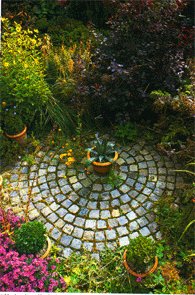|
The borders are waist
deep with flowers and foliage, the roses and lawn have vanished and all
that remains of the old garden is a stately pear tree. This now provides
shade for a seating area surrounded by majestic shuttlecock ferns, Matteuccia
struthiopteris, which is linked to another patio near the house by a gently
curving path of plain, reclaimed concrete paving slabs. "It's become
plants versus the hard landscaping," says Adrian, and it's a contest
the plants seem to be winning. 
The planting design uses a framework of shrubs to give strength and structure
to the garden. Cotinus coggygria 'Royal Purple', with its circular, deep-purple
leaves, is the perfect companion for the delicate Japanese maple, Acer
japonicum 'Aconitifolium', and together they give just the right effect
for Adrian. "I like to use plants that, complement as well as contrast.
Foliage and colours have to work well together," he says.
The theme of colour
contrast continues with valuable evergreen screening provided by the combination
of a deep green, glossy-leaved cherry laurel, Prunus laurocerasus, and
the tiny golden-leaved, shrubby honeysuckle, Lonicera Nitida 'Baggesen's
Gold'. "The evergreens are good in winter, especially with the dead
stems and seed-heads of the perennials left to die back naturally,"
says Adrian.
Despite letting plants
take the upper hand in his garden, Adrian is not a slave to maintenance.
"In the spring I spend about half a day a week working in the garden,
and during the summer perhaps only half an hour. I like to let things
get overgrown, but I also like to be there ready, in case something gets
out of hand," he says.
|
Adrian's
low-maintenance garden is a place for relaxation and enjoyment,
rather than hard graft...
|
|
 The
time he does give to the garden is spent looking after the grasses and
perennials that grow around, through, over and under the shrubs. "You
don't need rolling acres to achieve a prairie style," he adds. The
grasses give important. vertical impact to the garden. The flowers of
the giant feather grass, Stipa gigantea, sway in the lightest of
breezes, while the bronze flowers of its smaller cousin, Stipa tenuissima,
scramble over Geranium procurrens, giving a strong textural feel. The
time he does give to the garden is spent looking after the grasses and
perennials that grow around, through, over and under the shrubs. "You
don't need rolling acres to achieve a prairie style," he adds. The
grasses give important. vertical impact to the garden. The flowers of
the giant feather grass, Stipa gigantea, sway in the lightest of
breezes, while the bronze flowers of its smaller cousin, Stipa tenuissima,
scramble over Geranium procurrens, giving a strong textural feel.
Adrian explains, "The grasses are really important to me and I keep
finding new ones. I want to replace the Stipa gigantea with Molinia caerulea
ssp. arundineacea 'Windspiel'. It forms tighter clumps, and the stipa
doesn't like wet winters." In a garden like Adrian's. it's clear
that there is no point in using species that struggle. This is survival
of the fittest. This policy ensures a dynamic garden that is never the
same two weeks, or even two days, running. 
This constant change
becomes evident when Adrian is asked about his favourite plants. "Oh
gosh!" he exclaims. "Every day there's something that looks
great. Geranium maderense is doing really well at the minute. People say
it's not hardy, but I've got about 20 of them in pots. They like the microclimate
of this garden." At other times of the year different plants feature
at the top of his list. "In winter, the scent of Daphne laureola
is fantastic," he enthuses. This dwarf evergreen bears clusters of
yellow-green flowers beneath strong leathery foliage in late winter, when
most gardens look bare. He continues, "I've got several Buxus sempervirens,
the common evergreen box, in pots. I really like their formality against
the rest of the garden in winter, especially when the frost settles on
them."
It is apparent that,
in spite of Adrian's claim to the contrary, his "planned-unplanned"
garden is actually very well planned indeed. "It's not difficult
though," he says. "If you just plant what you like and you plant
closely, using species that spread randomly and do their own thing, then
you can just sit back and let it happen."
For Adrian, gardening
is never a chore. "Having a garden is similar to a partnership that
you're wedded into. It's about the sheer possibilities
of what you can do together," he says.

He is clearly dedicated to his garden,  which
is successful on so many levels. This applies not only to the plants and
the planting combinations but also to the lack of hard work involved.
There is no need for cutting grass or weeding, as dense planting ensures
there are no gaps for weeds, and the mass of plants ensures a continuous
display. Its many contrasts and moods combine to make a beautiful year-round
garden, providing Adrian with a little piece of paradise in the midst
of the suburbs. "I don't want to be big headed, but I don't think
there is a bad bit in this garden. It'll never be finished and it's always
going to evolve. but right now it's at a stage of maturity I'm happy with." which
is successful on so many levels. This applies not only to the plants and
the planting combinations but also to the lack of hard work involved.
There is no need for cutting grass or weeding, as dense planting ensures
there are no gaps for weeds, and the mass of plants ensures a continuous
display. Its many contrasts and moods combine to make a beautiful year-round
garden, providing Adrian with a little piece of paradise in the midst
of the suburbs. "I don't want to be big headed, but I don't think
there is a bad bit in this garden. It'll never be finished and it's always
going to evolve. but right now it's at a stage of maturity I'm happy with."

|

